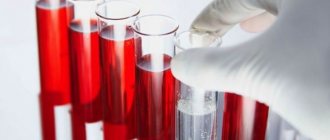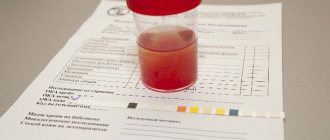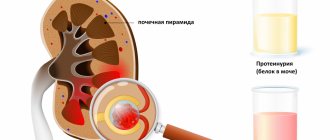Immunoglobulin type E or IgE is a specific class of immunoglobulins that is almost not synthesized in the body of a healthy person. An increase in its level in the blood acts as a marker of inflammation, including allergic origin. Patients with recurring allergic reactions are offered to donate blood for immunoglobulin E. Due to its complex composition and wide variety, the IgE type and its associated antibodies will give the doctor an understanding of what exactly caused the atypical immune response.
What is immunoglobulin E
IgE was first identified as a separate class in the late 60s of the last century. Even then, it was considered as the main marker of atopic and malignant processes associated with an abnormal response of the human immune system to irritants. In its structure, this bioactive compound is a five-component (consisting of five domains) polypeptide, each domain of which consists of 110 amino acids.
Among all immunoglobulins, IgE has the shortest lifespan. The period of its complete elimination from the blood is only 2-3 days, so to detect it, periods of exacerbation of inflammation and allergic reactions are chosen. Otherwise, the result may be false negative. At the same time, immunoglobulin E is synthesized more slowly than other immunoglobulins.
The unit of measurement for the concentration of immunoglobulin E in the blood is IU (international unit) per 1 ml of blood or serum. Also, in test results, the quantitative indicator of IgE can be indicated in kilounits (kU) per 1 liter of blood or serum.
The participation of IgE in an allergic reaction is that they are concentrated around mast and basophilic cells of the body. They attach to them through specific receptors. When immunoglobulin E captures the irritant antigen and combines with it, a reaction is triggered that leads to a sharp release of inflammatory mediators. The result of this complex biochemical process is an allergic reaction. It is this feature that allows us to identify the nature of the allergic reaction, as well as establish its intensity.
Normal value for immunoglobulin G
The following reference values have been established for IgG:
| Age | Floor | IgG, g/l |
| 0 – 1 month | Male | 3,97 – 17,65 |
| Female | 3,91 – 17,37 | |
| 1 – 12 months | Male | 2,05 – 9,48 |
| Female | 2,03 – 9,34 | |
| 1 – 2 years | Male | 4,75 – 12,1 |
| Female | 4,83 – 12,26 | |
| 2 – 80 years | Male | 5,4 – 18,22 |
| Female | 5,52 – 16,31 |
Note: It should be noted that each laboratory has the right to establish its own range of normal values. It is advisable to take tests and undergo treatment at the same medical institution.
Factors of influence
There are factors that can distort test results:
- intense sports activities;
- excessive stress and worry;
- taking alcohol or drugs, smoking;
- long-term use of drugs to enhance immunity;
- taking certain medications: carbamazepine;
- phenytoin;
- methylprednisolone;
- hormonal drugs (estrogen, oral contraceptives);
- valproic acid;
- gold preparations;
- cytostatics;
- immunosuppressants (drugs for artificial suppression of immunity);
It is advisable to assess the state of general immunity and diagnose pathologies after a comprehensive study of immunoglobulins of all classes.
Indications for the study
Indications for a blood test for immunoglobulin E are diseases and conditions associated with this substance. These include:
- dermatographism - a specific skin reaction in the form of urticaria or redness in places that came into contact with hard, blunt objects (literally drawings on the skin), disappearing spontaneously 30-40 minutes after occurrence;
- repeatedly exacerbating dermatitis, widespread throughout the body;
- increased skin sensitivity to household chemicals, cosmetics, food products;
- increased sensitivity to food, expressed by intestinal symptoms or dermatitis;
- long-term exacerbation of sinusitis, rhinitis, bronchitis and attacks of bronchial asthma of unknown origin.
Indications for the study also include:
- an allergic reaction, the source of which cannot be determined from anamnesis, including by keeping a daily diary of an allergy sufferer;
- unclear or questionable results of skin tests that did not give a clear picture of the degree of sensitization to a specific allergen, or giving reason to assume a false negative result;
- impossibility of performing skin tests - history of increased sensitivity to reagents, high risk of anaphylactic shock, taking antihistamines with the impossibility of stopping them even for a short time;
- patient's reluctance to do skin tests.
Also, an analysis for immunoglobulin E is carried out to clarify the diagnosis, when it is necessary to establish the specificity of the allergen and the degree of sensitivity of the body to it. This data is necessary to create an effective treatment plan.
Good to know: The examination is not carried out when skin tests are sufficient to make an accurate diagnosis.
What kind of analysis is this
A test for general immunoglobulins E in the blood is used to diagnose allergies, but to search for the causative allergen, immunoglobulins E specific to it are identified. IgE, contained in free form in the blood serum, makes up 0.002% of all antibodies. When interpreting the indicators of total immunoglobulin ig e, allergists at the Yusupov Hospital take into account a number of factors:
- in approximately 1/3 of patients with atopic diseases, the level of total IgE does not exceed the norm;
- some patients with bronchial asthma have increased sensitivity to only one antigen, as a result of which their level of total immunoglobulin E may be within normal limits, while specific immunoglobulins E and skin test results will be positive;
- the concentration of total immunoglobulin E also increases with helminthic infestation, bronchopulmonary aspergillosis and some forms of immunodeficiency and normalizes after treatment;
- angioedema and chronic recurrent urticaria are not mandatory indications for determining total immunoglobulin E, since in most cases they are non-allergic in nature;
- antibodies of other classes that are specific for a given allergen may cause false negative results;
- exceptionally high concentrations of total IgE immunoglobulin may be due to nonspecific binding to various antigens.
Preparation
Despite the high specificity and sensitivity of immunoglobulin E tests, specific preparation is required to obtain a reliable result. To differentiate allergies from other types of inflammation, blood tests for eosinophils are first performed. These specific cells are also synthesized in the body against the background of helminthic infestations, allergic reactions, and asthma.
2-3 days before the analysis, you need to start keeping a diary, which will indicate:
- all food products taken, especially those with allergenic properties (nuts, fruits, etc.);
- symptoms and manifestations indicating allergies that occurred before the study;
- contacts with non-food products and substances with allergenic properties during the designated period.
The information from the diary will provide valuable information for selecting an allergen panel. This will save money on diagnostics.
Also, to obtain a reliable result, a blood test for IgE is recommended to wait until the reaction worsens: the appearance of a rash, urticaria, runny nose, rhinitis, bronchial asthma, conjunctivitis and other manifestations. In the absence of symptoms, the results may show an incorrect picture.
Allergies in children: features and causes
Just a couple of centuries ago, the world did not even know what an allergy was, but today every third child suffers from it. At the same time, the symptoms of the disease often pass “under the guise” of completely different diseases, which can lead down the wrong path of treatment. So how not to confuse childhood diseases and identify their real cause?
How does it arise
All allergic reactions can develop in at least 4 ways, but in this article we will talk about the first and most common of them - the IgE-dependent way.
The characteristics of a child’s body, especially in the 1st year of life, normally protect the child from the development of allergies. The immune system is designed in such a way as to “introduce” the baby to the abundance of surrounding antigens, without causing pathological conditions.
In some cases, this mechanism fails, which may be due to:
- heredity (one parent “with allergies” - 30% risk of pathology in the child, both parents - 60% risk);
- violation of the barrier function of mucous membranes;
- innate characteristics of immunity.
In this case, at the first “meeting” with an allergen, the body only “remembers the unpleasant object” (begins the synthesis of IgE antibodies to the allergen), and the second time it “attacks” it.
The protection mechanism is implemented due to biologically active substances released by cells “on command” of IgE antibodies, and manifests itself:
- expansion of capillaries and increase in their permeability = redness and swelling (to accelerate the entry of immune cells into the lesion),
- irritation of nerve endings and spasmodic contraction of the “target” muscles = itching, coughing, sneezing (as a way to mechanically “get rid” of the allergen),
- increased mucus production = runny nose (to facilitate binding and removal of the “irritating” object).
Interestingly, allergies and acute respiratory viral infections have similar “points of application”. This causes the similarity of symptoms, as well as the tendency of allergy sufferers to acute respiratory diseases.
Symptoms and causes
Conventionally, allergic diseases can be divided into respiratory (inhaled antigens) and food. Symptoms of the former range from a slight runny nose to severe suffocation, while the latter have skin and “digestive” manifestations.
A “respiratory” allergy in a child can manifest itself not only with classic symptoms, but also simply with a “constantly stuffy nose,” and the cause may be:
1.mites (house dust, feather duster, flour mite and others)
This allergy appears upon contact with dust (household dust, books) and carpets, and most often occurs in a certain room.
2.down and feathers of birds
The reaction can be associated with both live birds (parrots, canaries and others) and with bedding (pillows and blankets), in which down and feathers are used as filler. In the second case, the allergy most often manifests itself during sleep and immediately after waking up (nasal congestion or cough that goes away during the day)
3.dander and epithelium of animals (cats, dogs, hamsters, guinea pigs, horses, etc.).
At the same time, wool (hairs) itself is safe in the context of allergies. The reaction is caused by skin elements that accumulate on the fur.
4. “domestic” molds
They live in warm, damp and poorly ventilated places in the room: seams between tiles in the bathroom and the space under the wallpaper of “damp” walls. Symptoms are often severe and only subside with prolonged stay outside the “allergenic” room.
5.trees and grass
Allergies are seasonal and appear during the flowering period of the plant: late spring, summer or early autumn.
Skin symptoms, in mild cases, consist of an itchy rash that goes away when the allergen is eliminated. And more severe reactions are accompanied by the development of dermatitis, which is characterized by a chronic course and is difficult to treat.
Thus, bowel irregularities, abdominal pain, as well as nausea and loss of appetite in a child may well be signs of an allergy and require a comprehensive examination.
Among the most “significant” food allergens in children are:
1. cow's milk proteins : β-lactoglobulin, a-lactalbumin, bovine serum albumin, and casein.
Depending on the reaction to certain proteins, dairy products should be excluded partially or completely.
2.chicken egg whites : ovomucoid, ovalbumin, lysozyme.
3.nuts;
4.cereal proteins, especially gliadin (gluten) of wheat and rye, barley and oats;
5.fish and seafood;
6.cocoa, citrus fruits and soy.
Diagnostics
It is often not possible to distinguish allergies from similar diseases by eye. “Experimentally” confirming the allergenic nature of symptoms can only be done by eliminating the “suspected” allergen. And in cases where there is none, laboratory tests can help in diagnosis.
The first stage of diagnosis serves to confirm the allergic nature of the disease and is based on:
1.1 General blood test with leukocyte formula, where eosinophils serve as a marker of allergy.
1.2. A blood test for immunoglobulin E, total and eosinophilic cationic protein, which increases tens and hundreds of times during allergies.
1.3. Microscopic examination of nasal secretions (nasal swab), also aimed at identifying eosinophils.
After establishing allergy as the main diagnosis, you can move on to determining the subgroup or the allergen itself.
The first option is used in case of doubt regarding the source of the allergy, and prefabricated panels are used to narrow the “search circle”. They contain several representatives of an allergy group at once, and the result is given in one number.
These may be allergen panels
- herbs,
- trees,
- animals,
- ticks,
- mold fungi,
- meat,
- dairy,
- citrus
- and many others.
If you receive increased results in any of the panels, you can proceed to the third stage of diagnosis - identifying the allergen itself. To do this, use a blood test for IgE to individual allergens (for example, a specific mold or a representative of citrus fruits).
What do the results mean?
The level of immunoglobulins in the blood depends on many factors, including the patient’s age, genetic characteristics and ethnicity, the presence of chronic diseases and others. When interpreting the results, an allowance must be made for this.
Also, when conducting tests, you need to take into account the diagnostic limitations of IgE:
- enzyme immunoassay for IgE levels should not play a leading diagnostic role, especially if the diagnosis can be made by other, more affordable methods;
- the presence of specific IgE to specific allergens is not the main explanation for the occurrence of specific allergic symptoms;
- excessively high levels of immunoglobulin E may indicate a false positive result rather than hypersensitivity of the body to a specific allergen;
- even if the values of immunoglobulins of different specificities are equal, it does not mean that they equally influence the appearance of symptoms;
- the absence of immunoglobulin type E in the blood in the presence of symptoms of an allergic reaction (especially rhinitis, sinusitis) is not evidence that the symptoms are caused not by a specific immune reaction, but by infections, since IgE can be synthesized locally without entering the bloodstream.
Interpretation of the study results is carried out on the basis of comparison of the results obtained with normal indicators for healthy people, graded by age. These are considered:
- up to 15 kE/l - in children of the first year of life;
- up to 60 kE/l - in preschool children (from 1 year to 6 years);
- up to 90 kE/l - in children of primary school age (from 6 to 10 years);
- up to 200 kE/l - in adolescents (from 10 to 16 years);
- up to 100 kE/l - in adults and children over 16 years of age.
Deviations in the functioning of the immune system can be indicated by any changes in the levels of immunoglobulin E in the blood, including its increase or decrease. An elevated IgE level indicates the presence of the following diseases:
- allergic rhinitis (IgE level varies between 120-1000 kU/l);
- atopic dermatitis (from 80 to 14,000 kU/l);
- atopic bronchial asthma (from 120 to 1200 kU/l);
- gastroenteropathy of allergic origin (from 120 to 2000 kE/l);
- angioedema (up to 8000 kU/l);
- helminthiasis (from 120 to 12,000 kU/l);
- myeloma (above 15,000 kU/l);
- genetic diseases affecting the immune system - Jobe, Wiskott-Aldridge, DiGeorge syndromes and others.
A decrease in immunoglobulin E levels may indicate ataxia. To make a final diagnosis, the results obtained are compared with the clinical picture, the patient’s medical history and data from additional studies are taken into account.
Immunoglobulin E (Ig E) general - diagnosis of allergic conditions
Material for research: blood serum.
Research method: IECHL.
Execution time: 1 working day.
Blood collection for general Immunoglobulin E (Ig E) is performed at all BRIGHT-Bio points.
Determination of the content of total Ig E in blood serum is used to diagnose atopic allergic diseases.
Preparation for the study: blood is taken on an empty stomach. At least 8 hours (preferably 12 hours) must pass between the last meal and the test. Juice, tea, coffee (especially with sugar) are not allowed. You can drink water.
The half-life of immunoglobulin class E ( Ig E) is 3 days in blood serum, and 14 days on the membranes of mast cells and basophils. The mechanism of atopic allergic reactions is closely related to immunoglobulins E. They have the ability to quickly fix on skin cells, mucous membranes, mast cells and basophils, therefore free Ig E is present in the blood plasma in small quantities. In addition to participating in type 1 allergic reactions , Ig E also takes part in protective anthelminthic immunity, which is due to the existence of cross-linking between Ig E and the helminth antigen.
Elevated Ig E in children with allergies and hypersensitivity to a large number of allergens are detected more often than in children with hypersensitivity to a small number of allergens, as well as in children whose target organs are not involved in the allergic process. Ig E levels in sick children with hypersensitivity to food and pollen allergens is higher than in children with hypersensitivity to house dust and mold.
In adults, determining the level of Ig E has less diagnostic value than in children. Elevated levels of Ig E are detected only in 60% of patients suffering from atopic bronchial asthma. The highest values of Ig E in the blood are observed with hypersensitivity to a large number of allergens in combination with asthma, dermatitis and rhinitis. With hypersensitivity to one allergen, the level of total Ig E may be within normal limits.
Allergic bronchopulmonary aspergillosis is accompanied by a significant increase in the level of Ig E in the blood. Its concentration is increased in almost every patient with allergic aspergillosis during the period of pulmonary infiltration.
Ig E level in patients with active lung disease excludes the diagnosis of aspergillosis.
When assessing the results of determining total Ig E , it should be borne in mind that in approximately 30% of patients with atopic diseases, the level of this immunoglobulin may be within normal limits.
When diagnosing an allergy, it is not enough to note an increase in total Ig E in the blood. Ig E antibodies against it.
Since the beginning of 2011, the BRIGHT-Bio laboratory has been determining allergen-specific Ig E in blood serum to various allergens grouped in panels.
- Allergy panel Polycheck Pediatric No1 (APPd1)
BRIGHT-Bio is making efforts to expand the list of Allergy panels.
The detection of allergen-specific Ig E (to any allergen or antigen) does not yet prove that this particular allergen is responsible for the clinical symptoms. The final conclusion and interpretation of the results should be made only after comparison with the clinical picture and allergy history data. The absence of specific Ig E in the blood serum does not exclude the possibility of participation in the pathogenesis of the disease Ig E -dependent mechanism, since local synthesis of Ig E and sensitization of mast cells can occur in the absence of specific Ig E in the bloodstream (for example, with allergic rhinitis).
Why is an elevated level of immunoglobulin dangerous?
Immunoglobulin IgE is a structural part of the body's natural immune defense. Its initial role is to neutralize pathogenic organisms (bacteria, viruses and helminths) on mucosal surfaces. They attract immunoglobulins G, eosinophils, neutrophils and other biologically active substances to the area where pathogens invade, getting rid of the threat. Therefore, it would be incorrect to talk about the harm of IgE during the normal functioning of the immune system.
A completely different picture unfolds with an atypical increase in IgE in response to their reaction with allergens. In this case, the immunoglobulin “raises troops” against a non-existent enemy, and the cells called upon to protect the body attack its own tissues. However, even with its increase, we cannot say that it is IgE that threatens human health. First of all, it is a marker indicating existing disorders that can be corrected under the guidance of a competent doctor.
Allergy development phases
I want to talk to you now about something simple. You need to understand that the initial entry of allergens into the blood usually never causes allergic reactions, because during this period the immunological phase of pathogenesis begins to form. What does it mean? The allergen enters the bloodstream, genetic cells must recognize the “stranger”, then they transmit information to other cells, these cells become excited and begin to respond.
First phase
During the manifestation of an allergy, when a genetic foreigner enters, very complex processes take place in our body at the cellular level. And in this first immunological phase, as a rule, both T-cells and B-cells of lymphocytes are prepared. These are the two main groups of cells in our immune system that are activated when we encounter a genetic foreigner. In addition, the body begins to produce immunoglobulin-E after exposure to an allergen. And the immunological phase, as it were, prepares the immune system for the fact that when a genetic stranger is reintroduced, it will be fully armed. It’s good if it’s, say, a flu virus. Yesterday, the immune system encountered this virus in small quantities, and after a while it met this virus fully armed and is ready to fight back during an epidemic or pandemic. And if this is some kind of protein structure of plant pollen and a person has nowhere to go, he lives in the forest and around him there are a large number of certain trees, on which his immune system suddenly reacted aggressively.
Second phase
During initial contact with an allergen and antigen, as a rule, nothing happens in the immunological phase. The second phase of general pathogenesis is divided into the pathochemical phase. In this phase, there is a release of biologically active substances that can cause certain reactions in the body, or affect certain reactions in the body. It is in the pathochemical phase that the so-called cellular mediators will be released. What does it mean? In our immune system cells we have mast cells, which contain biologically active substances, in particular histamine, in vacuoles. In the tissues of the organs of the system, on the skin, on the mucous membrane, in the gastrointestinal tract, in the cardiovascular system, there are receptors that are sensitive to histamine. And if for some reason the mast cell either ruptures or opens slightly and histamine enters the blood, after a split second this histamine has a sharp effect on certain receptors that we have in our tissues and organs. Particularly on the skin.
Third phase
And what do we then see in the third pathophysiological phase, or the phase of clinical manifestations? We see the manifestation of the allergy itself. For example, histamine interacted with skin cells - we see hives and allergic rashes. Histamine interacted with the cells of the bronchopulmonary tree - we see bronchospasm or a severe attack of bronchial asthma. When interacting with intestinal cells, we see diarrhea, which can very often accompany this process; this is one of the manifestations of allergies. It affects myocardial cells - we see a disturbance in the rhythm of the heartbeat.
When this happens, why does this mast cell suddenly become indignant and begin to release histamine into the blood? Such situations happen when the immunoglobulin produced during the immunological phase sits on top of the mast cell receptors and begins to somehow crush or train it so that histamine is released into the blood faster. When we see situations where immunoglobulin-E is elevated, it may be generally elevated.









